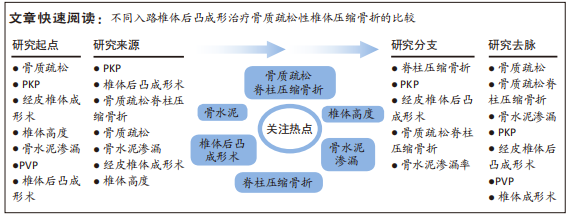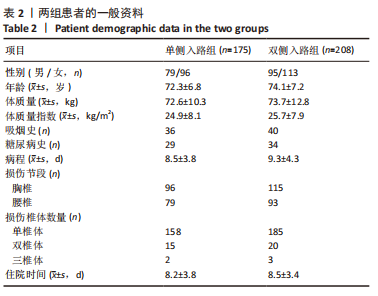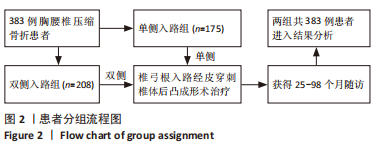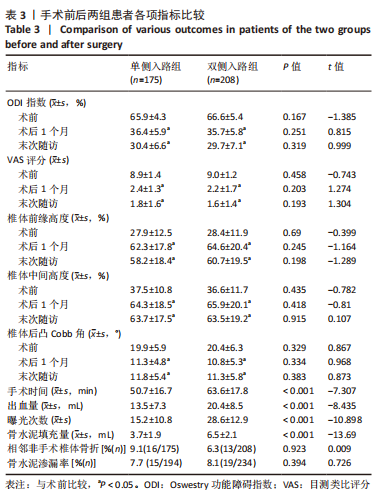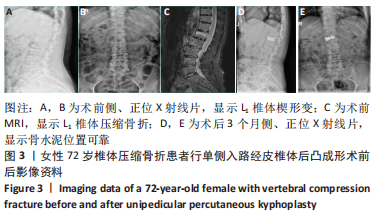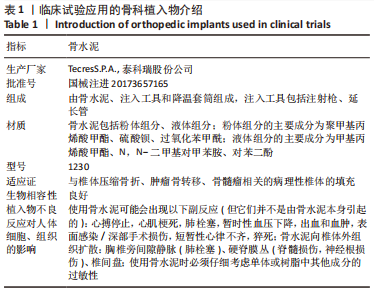[1] DAI C, LIANG G, ZHANG Y, et al. Risk factors of vertebral re-fracture after PVP or PKP for osteoporotic vertebral compression fractures, especially in Eastern Asia: a systematic review and meta-analysis. Orthop Surg Res. 2022;17(1):161.
[2] WEI H, DONG C, ZHU Y, et al. Analysis of two minimally invasive procedures for osteoporotic vertebral compression fractures with intravertebral cleft: a systematic review and meta-analysis. Orthop Surg Res. 2020;15(1):401.
[3] CHEN X, GUO W, LI Q, et al. Is Unilateral Percutaneous Kyphoplasty Superior to Bilateral Percutaneous Kyphoplasty for Osteoporotic Vertebral Compression Fractures? Evidence from a Systematic Review of Discordant Meta-Analyses. Pain Physician. 2018;21(4):327-336.
[4] YIN P, JI Q, WANG Y, et al. Percutaneous kyphoplasty for osteoporotic vertebral compression fractures via unilateral versus bilateral approach: A meta-analysis. Clin Neurosci. 2019;59:146-154.
[5] TAN B, YANG QY, FAN B, et al. Is It Necessary to Approach the Severe Osteoporotic Vertebral Biconcave-Shaped Fracture Bilaterally During the Process of PKP? Pain Res. 2021;14:1601-1610.
[6] FAIRBANK JC, PYNSENT PB. The Oswestry Disability Index. Spine. 2000; 25:2940-2953.
[7] YEOM JS, KIM WJ, CHOY WS, et al. Leakage of cement in percutaneous transpedicular vertebroplasty for painful osteoporotic compression fractures. J Bone Joint Surg Br. 2003;85(1):83-89.
[8] POLIKEIT A, NOLTE LP, FERGUSON SJ. The effect of cement augmentation on the load transfer in an osteoporotic functional spinal unit:finite-element analysis. Spine. 2003;28(10):991-996.
[9] TOHMEH AG, MATHIS JM, FENTON DC, et al. Biomechanical efficacy of unipedicular versus bipedicular vertebroplasty for the management of osteoporotic compression fractures. Spine. 1999;24(17):1772-1776.
[10] STEINMANN J, TINGEY CT, CRUZ G, et al. Biomechanial comparison of unipedicular versus bipedicular kyphoplasty. Spine. 2005;30(2):201-205.
[11] 李忠海, 侯树勋, 吴闻文, 等. 一种新型椎体后凸成形球囊扩张器的有限元分析[J]. 中华创伤骨科杂志,2014,16(3):222-226.
[12] 刘瑞祯,王望任,郝晨, 等.骨水泥分布对单侧穿刺经皮椎体成形治疗单节段骨质疏松性椎体压缩骨折后相邻椎体骨折的影响[J].中国组织工程研究,2020,24(28):4498-4504.
[13] BARR JD, BARR MS, LEMLEY TJ, et al. Percutaneous vertebroplasty for pain relief and spinal stabilization. Spine. 2000;25:923-928.
[14] AMAR AP, LARSEN DW, ESNAASHARI N, et al. Percutaneous transpedicular polymethylmethacrylate vertebroplasty for the treatment of spinal compression fractures. Neurosurgery. 2001;49(5): 1105-1114; discussion 1114-1115.
[15] DERAMOND H, DEPRIESTER C, GALIBERT P, et al. Percutaneous vertebroplasty with polymethylmethacrylate. Technique, indications, and results. Radiol Clin North Am. 1998;36(3):533-546.
[16] PAPANASTASSIOU ID, FILIS A, GEROCHRISTOU MA, et al. Controversial issues in kyphoplasty and vertebroplasty in osteoporotic vertebral fractures. Biomed Res Int. 2014;2014:934206.
[17] KWON HM, LEE SP, BAEK JW, et al. Appropriate Cement Volume in Vertebroplasty: A Multivariate Analysis with Short-Term Follow-Up. Korean J Neurotrauma. 2016;12(2):128-134.
[18] FU Z, HU X, WU Y, et al. Is There a Dose-Response Relationship of Cement Volume With Cement Leakage and Pain Relief After Vertebroplasty? Dose Response. 2016;14(4):1559325816682867.
[19] NIEUWENHUIJSE MJ, BOLLEN L, VAN ERKEL AR, et al. Optimal intravertebral cement volume in percutaneous vertebroplasty for painful osteoporotic vertebral compression fractures. Spine. 2012; 37(20):1747-1755.
[20] SUN HB, JING XS, LIU YZ, et al. The Optimal Volume Fraction in Percutaneous Vertebroplasty Evaluated by Pain Relief, Cement Dispersion, and Cement Leakage: A Prospective Cohort Study of 130 Patients with Painful Osteoporotic Vertebral Compression Fracture in the Thoracolumbar Vertebra. World Neurosurg. 2018;114:e677-e688.
[21] 杨惠林, 陈亮, 陆俭, 等. 椎体后凸成形术治疗老年骨质疏松脊柱压缩骨折[J]. 中华骨科杂志,2003,23(5):262-265.
[22] ROTTER R, PFLUGMACHER R, KANDZIORA F, et al. Biomechanical in vitro testing of human osteoporotic lumbar vertebrae following prophylactic kyphoplasty with different candidate materials. Spine. 2007;32(13):1400-1405.
[23] KAWANISHI M, ITOH Y, SATOH D, et al. Percutaneous vertebroplasty for vertebral compression fracture. No Shinkei Geka. 2006;34(8):793-799.
[24] VOORMOLEN MH, LOHLE PN, JUTTMANN JR, et al. The risk of new osteoporotic vertebral compression fractures in the year after percutaneous vertebroplasty. J Vasc Interv Radiol. 2006;17(1):71-76.
[25] FRIBOURG D, TANG C, SRA P, et al. Incidence of subsequent vertebral fracture after kyphoplasty. Spine. 2004;29(20): 2270-2276; discussion 2277.
[26] BAROUD G, NEMES J, HEINI P, et al. Load shift of the intervertebral disc after a vertebroplasty:a finite element study. Eur Spine J. 2003; 12(4):421-426.
[27] 沈松,徐彬.经皮椎体成形骨水泥呈弥散型分布可减少邻近椎体再骨折的发生率[J].中国组织工程研究,2022,26(4):499-503.
[28] GRAHAM J, AHN C, HAI N, et al. Effect of bone density on vertebral strength and stiffness after percutaneous vertebroplasty. Spine. 2007; 32(18):E505-511.
[29] DONG C, ZHU Y, ZHOU J, et al. Therapeutic Efficacy of Third-Generation Percutaneous Vertebral Augmentation System (PVAS) in Osteoporotic Vertebral Compression Fractures (OVCFs): A Systematic Review and Meta-analysis. Biomed Res Int. 2022;2022:9637831.
[30] MAO W, DONG F, HUANG G, et al. Risk factors for secondary fractures to percutaneous vertebroplasty for osteoporotic vertebral compression fractures: a systematic review. Orthop Surg Res. 2021;16(1):644.
|
